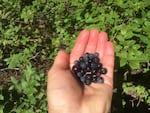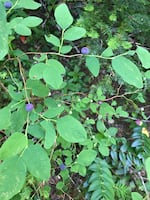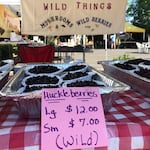When I was growing up along the Rocky Mountains, huckleberries were a summer staple. The high elevation, dense forest cover and cool nights made for ideal growing conditions. There was even a shop in the small town of Victor, Idaho, where we would go for huckleberry milkshakes at the end of a hot summer day.
Or that’s what I thought. What I always knew as huckleberries are actually just native blueberries.
“Huckleberries are not technically huckleberries,” said Bernadine Strik, a professor of horticulture and a berry crops specialist at Oregon State University. “Common names can be misleading.”
Strik has been researching berries in the Pacific Northwest for more than three decades. Strik said while true huckleberries are related to blueberries, it’s an entirely different genus.
“What we commonly called huckleberry [in the West] are native blueberry species, and all the different huckleberries that we have here are genus Vaccinium which is the same genus as commercial blueberries,” Strik said. “And the same genus as other native blueberry species.”
Related: Have a story idea for 'Curious Northwest'? Share it with us
In the West, there are at least seven Vaccinium species growing wild across Oregon, Washington, Idaho and parts of western Montana and western Wyoming. In the Northeast, there are Vaccinium corymbosum. Florida and the Southeast have Vaccinium darrowii and Vaccinium virgatum.
“Interestingly, they don’t call them huckleberries,” Strik said. “But here in the West, for some reason, we’ve called them huckleberries, even though they’re native blueberries.”

Professor Bernadine Strik holds a handful of Vaccinium membranaceum, commonly called Mountain Huckleberries.
Bernadine Strik/Oregon State University
Strik explained that true huckleberries, Gaylussacia baccata, have 10 large seeds and are only native to Eastern North America. While they are blue and have a similar look as a blueberry, those 10 large seeds are kind of hard to miss.
So why is there such a difference in flavor between what Westerners call huckleberries and the blueberries we buy at the market?
Strik said that may be partially due to their smaller size. In the Vaccinium species, most of the flavor and aroma compounds are in the skin of the berry.
“So when you have a smaller-fruited cultivar, many people tend to notice the flavor is more intense,” Strik said. “And that’s because you get a higher skin-to-pulp ratio.”
Still, the name is hard to shake, so we’ll split the difference and call these Vaccinium varieties Western huckleberries.
Bountiful berries
For thousands of years, Northwest tribes have harvested Western huckleberries for both food and traditional medicines. But these plants also hold a cultural and spiritual significance, with Western huckleberries playing a role in traditional legends and harvest times, offering an opportunity to gather with friends and family.
Western huckleberries thrive at higher elevations, where the soil is acidic, frequently in areas burned by wildfire. Indigenous peoples often maintained huckleberry habitat by using controlled burns to thin overgrowth and open the canopy.

Bright purple berries and rounded leaves of a Vaccinium ovalifolium, or oval-leafed Huckleberry.
Bernadine Strik/Oregon State University
“The native peoples used fire as a pruning mechanism every five or so years when the native blueberries, or huckleberries, started [growing] in too dense of shade,” Strik said.
It’s a practice that Indigenous groups such as Puget Sound’s Tulalip Tribe and the Confederated Tribes and Bands of the Yakama Nation are working with the U.S. Forest Service to preserve and recreate.
For decades, Oregon has been considered one of the leading berry crop production regions in the world, so it’s no surprise that Oregon is also the home to a one-of-a-kind berry breeding program between Oregon State University and USDA Agricultural Research Service.
“It is a partnership that’s over a hundred years old and is specific to developing new cultivars,” said Strik. “It’s the only cooperative breeding program of its kind in the world.”
Since 1917, this collaboration has developed new berry crop varieties for the Pacific Northwest. The partnership between OSU and USDA-ARS is behind some of the most iconic berries, like Marion blackberries and Hood strawberries, both developed by berry breeder George F. Waldo.
“We are rife with native berry crops here in Oregon,” Strik said. “Which is a testament to the climate that we have.”
Climate is critical to Western huckleberries. In fact, it is one of the main reasons you don’t see the berries growing in backyards across the country.
Related: Northwest huckleberries could be close to domestication
Strik was quick to point out that both the evergreen huckleberry and the red huckleberry are available and can be grown at home, but many other Western varietals need specific conditions to thrive.
“If you’re a home gardener and you’re at a high elevation, absolutely you can buy mountain huckleberry and oval-leafed huckleberry at a native-plant nursery,” Strik said. But “there’s a difference between growing a plant and getting fruit on it.”
One of the challenges is that many Western huckleberry varieties are adapted to high elevations. They need the colder winters and less sun, thriving in the shorter growing season of high elevations. The plants are also used to the increased humidity that comes with rain and mountain fog.
Strik said she often gets asked why commercial growers aren’t producing Western huckleberries. She explained that in addition to not being adapted to grow at lower elevations, even in ideal conditions, the plants just don’t produce a lot of fruit.
“[They grow] one berry per cluster or two berries at the most per cluster,” Strik said. “You look at our commercial blueberries, we have as many as 10 berries per cluster that are much bigger.”
Forage yourself or prepare to pay
Western huckleberry season is short, lasting only a few weeks between August and September, and if you’re not foraging them yourselves, prepare to pay a pretty penny.
At my local farmer’s market, huckleberries made their first appearance the second weekend of August at a price point of $12-$14 per pound.

Foraged huckleberries at the Wild Things stand at the Lents International Farmers Market in Portland, Ore.
Courtesy of the Lents International Farmers Market
“Consider yourself fortunate that someone else has gone out to pick them,” Strik said, “because the berries on these are really sparse [and] it takes a heck of a lot of work to pick a pound of huckleberries.”
Someone who knows that first hand is Tim McCarty. He’s been foraging for berries and mushrooms for over four decades and currently has a market stand called Wild Things at the Lents International Farms Market in Portland.
“Most people don’t like to do it,” said McCarty. “People don’t understand if you have never done it, you don’t know how long it takes to pick a pound of huckleberries.”
McCarty doesn’t mind, though. “I just like doing it. I sit out there. I mean, what’s wrong with looking up and seeing the mountain, you know? When you’re out in the middle of the woods with nobody around, it’s very nice there.”
You also need to know where to find Western huckleberries, which can be a challenge in itself. Many pickers, McCarty included, are secretive about the best berry spots.
“It’s just like my fishing spots,” McCarty said. “I have some really good fishing spots, but I don’t take anybody there except my kids.”

Huckleberry forager Tim McCarty of Wild Things cools off with a lemonade after a 100-degree day at the Lents International Farmers Market.
Crystal Ligori/OPB
Both Oregon and Washington require permits for anyone harvesting Western huckleberries on public lands — in part, to maintain future huckleberry populations, but also because some areas, like parts of the Sawtooth Berry Fields, are reserved as Native harvesting sites.
But if you don’t have anyone to share their berry-picking spots with you, don’t be discouraged. According to Strik, Western huckleberries are so prevalent, you’ll find them almost anywhere you hike in the Cascades or Klamath mountain ranges.
“Any of the hikes around Mount Hood, Mount Rainier, Mount St. Helens, I’ve seen plentiful Vaccinium membranaceum, or mountain huckleberry and oval-leaf huckleberry,” Strik said. “Depending on the time of year, it’s amazing how much you can munch while you’re hiking.”
McCarty echoed that sentiment, saying folks could head anywhere above 2,000 feet and “just ask the forest service people, they’ll give you a permit and a map of where you can go.”
But, he cautioned, “that doesn’t mean there’ll be any huckleberries there.”
And if you do find some, make sure to adjust your expectations.
“Be prepared to spend a long time,” he said with a laugh, “and not get a lot of reward for your work.”
